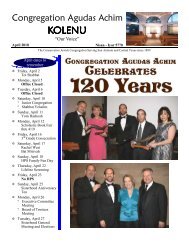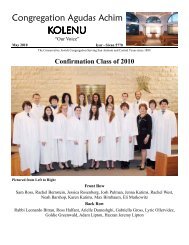LESSONS - Congregation Agudas Achim
LESSONS - Congregation Agudas Achim
LESSONS - Congregation Agudas Achim
Create successful ePaper yourself
Turn your PDF publications into a flip-book with our unique Google optimized e-Paper software.
Origins of the Jewish Bible<br />
You are sitting in shul at a Shabbat<br />
morning service. The ark opens. You and<br />
your family rise, kiss the Torah, and your<br />
child asks you, “Dad, Mom, where does<br />
the Torah come from?”<br />
You say, “Well, God gave it to Moses and<br />
Moses wrote it and passed it on to the<br />
Jewish people. Generation after generation until today.” Good-<br />
-I say. Then you go home and wonder about it. Is the “original”<br />
Torah somewhere? You should know that all “original” copies of<br />
the individual biblical writings have eluded the excavators and<br />
us. Books of the Torah were probably written on papyrus made<br />
from the sliced stem of a plant, nowhere to be found. We are<br />
usually unaware that there is no “original” manuscript available.<br />
Most of the writings were done in a script that resembles the<br />
present writing. It was probably Old Hebrew or Phoenician<br />
script, which was also shared by Canaanites and Phoenicians.<br />
After the first exile in 586 BCE, the Aramaic script influenced<br />
the Hebrew language in the direction of the square script as we<br />
know it today.<br />
04<br />
We coded it.<br />
We designed it.<br />
We are also unaware that the oldest parchment scroll of the<br />
Torah dates from about 900 CE, which is probably more than<br />
1,300 years later than the likely time of the composition of the<br />
Torah. It is not too speculative to say that probably much has<br />
happened to the text in terms of its oral and written forms.<br />
The “version” we use in our synagogues is the Masoretic<br />
version. The Masoretes were scholars who, over the centuries,<br />
attempted to preserve the “best text.” One of these versions<br />
was produced in Tiberias, Israel in the tenth century CE, and<br />
from that scroll we have made copies.<br />
Someone once wrote, “The birth of a text is like the birth of<br />
a human being. The umbilical cord connects the text with its<br />
producers and with the time in which it was produced. When<br />
the cord is severed, its existence has become a fact; the text is<br />
now going to live its own life . . .”<br />
B’Shalom,<br />
Rabbi Leonardo Bitran<br />
We created it.





